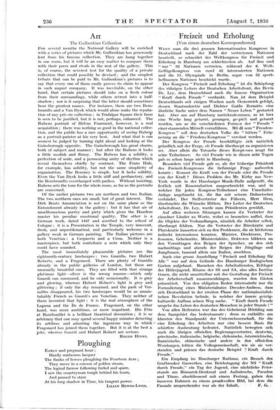Art
The Gulbenkian Collection FOR several months the National Gallery will be enriched with a series of pictures which Mr. Gulbenkian has generously lent from his famous collection. They are hung together in one room, but it will be an easy matter to compare them with their peers and rivals in the rest of the gallery. This is, of course, the severest test for the quality of a private collection that could possibly be devised ; and the simplest tribute that can be paid to Mr. Gulbenkian's pictures is to say that every one of them easily proves its claim to appear in such august company. It was inevitable, on the other hand, that certain pictures should take on a fresh colour from their surroundings, while others retreat into a half- shadow ; nor is it surprising that the latter should sometimes bear the greatest names. For instance, there are two Rem- brandts and a Van Dyck which would alone make the reputa- tion of any private collection ; in Trafalgar Square their fame is seen to be justified, but it is not, perhaps, enhanced. The Rubens portrait of Helene Fourment, however, is a real acquisition ; there was nothing so good in the national collec- tion, and the public has a rare opportunity of seeing Rubor as a portrait-painter at his very best. And what that is can soonest be judged by turning right about and looking at the Gainsborough opposite. The Gainsborough has great charm, both of subject and manner ; but after the Rubens it looks a little modish and flimsy. The Rubens has a solidity, a perfection of scale, and a permeating unity of rhythm which reveal themselves chiefly by contrast. The Frans Hals, for example, has solidity, but not the same simplicity of organisation. The Romney is simple, but it lacks solidity. Even the Van Dyck looks a little stiff and perfunctory, and the Rembrandts overcharged with pathos. Without insisting, Rubens sets the tone for the whole room, as far as the portraits are concerned.
Of the earlier pictures two are northern and two Italian. The two northern ones are small, but of great interest. The Dirk Bouts Annunciation is not on the same plane as the Entombment already in the gallery ; but it has that air of unselfconscious poetry and piety which gives the Haarlem master his peculiar emotional quality. The other is a German work, dated 1447 and ascribed to the school of Cologne ; it is a Presentation in the Temple, very innocent, fresh, and unproblematical, and particularly welcome in a gallery weak in German painting. The Italian pictures are both Venetian : a Carpaccio and a Cima. Neither is a masterpiece, but both contribute a note which only they could have sounded.
The most immediately pleasurable pictures are the eighteenth-century landscapes : two Guardis, two Hubert Roberts, and a Fragonard. There are plenty of Guardis already in the public galleries of London, but these are unusually beautiful ones. They are filled with that strange platinum light—silver is the wrong nuance—which only Guardi can command, and he only occasionally. It is grey and glowing, whereas Hubert Robert's light is grey and
glittering ; if only the sky remained, and the park of Ver- sailles disappeared, his two landscapes would be as unmis- takably French as Guardi's are Venetian. They neither of them invented that light : it is the real atmosphere of the Laguna and the Ile de France. Fragonard, on the other hand, was more ambitious, or more impatient. his Fete at Rambouillet is a brilliant theatrical decoration ; it is so arbitrary that one may spend several happy minutes detecting its artifices and admiring the ingenious way in which • Fragonard has joined them together. But it is at the best a joke, whereas Guardi and Hubert Robert are serious.
ROGER RINKS.






































 Previous page
Previous page